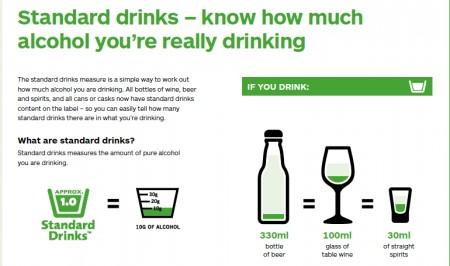Key points about alcohol guidelines
- it is best not to supply alcohol to rangatahi under 18
- it's not the amount of liquid you are drinking that's important – it's the amount of alcohol it contains
- it takes at least 1 hour – and sometimes much longer – to remove 1 standard drink from our bodies
- drinking alcohol has both immediate and long-term health effects
A standard drink
The standard drinks measure is a simple way for you to work out how much alcohol you are drinking. It reflects the amount of pure alcohol in a drink. One standard drink equals 10 grams of pure alcohol (about 2 teaspoons).
Check the amount of alcohol in each drink
It's not the amount of liquid you are drinking that's important – it's the amount of alcohol it contains. As different types of alcoholic drinks have different amounts of alcohol in them, the number of standard drinks in each can, bottle or cask, will also vary. You'll find the standard drink content on the label, container or packaging of each drink.
It takes at least 1 hour – and sometimes much longer – to remove 1 standard drink from our bodies. Women absorb and metabolise alcohol differently than men. They have higher blood alcohol concentration (BAC) after consuming the same amount of alcohol as men, and are more at risk of alcoholic liver disease, heart muscle damage, and brain damage.1,2

Know how much alcohol you're really drinking - check a guide to standard drinks.
See the guide, Te Whatu Ora – Health New Zealand website alcohol.org.nz
Some ways to lower the risks of drinking alcohol
Drinking alcohol has both immediate and long-term health effects. Because people are different – there is no amount of alcohol that can be said to be safe for everyone.
Low-risk drinking guidelines reflect the harms that might arise:
- from single drinking occasions - where there is a risk of injury to self or others
- from the long-term health consequences of regular drinking - such as increased risk of cancer, cardiovascular disease, diabetes, liver disease and addiction problems
Current long-term drinking guidelines give advice on how to lower your risk.3
For young people
Not drinking is the safest option for rangatahi under 18 years of age. Guidelines advise:
- it is best not to supply alcohol to rangatahi under 18
- try to delay drinking for as long as possible
- if under 18 year olds do drink, they should always be supervised, drink infrequently and at levels usually below and never exceeding 2 standard drinks
For adults
Guidelines advise:
- no more than 2 standard drinks a day for women and no more than 10 standard drinks a week
- no more than 3 standard drinks a day for men and no more than 15 standard drinks a week
Parenting Teens - Alcohol Facts
Acknowledgements
The Paediatric Society of New Zealand and Starship Foundation are very grateful to Northland District Health Board (NDHB) for permission to reproduce this content from the Whānau pack: Tools for families and parents with teenagers.
Copyright
NDHB own the copyright in this material and it must not be copied or reproduced except as expressly permitted by NDHB.
References
1. Urbano-Márquez, A.; Estruch, R.; Fernández-Solá, J.; Nicolás, J.M.; Paré, J.C.; & Rubin, E. The greater risk of alcoholic cardiomyopathy and myopathy in women compared with men. JAMA 274(2):149-154, 1995
2. Nixon, S.J. Cognitive deficits in alcoholic women. Alcohol Health & Research World 18(3):228-232, 1994
3. ALAC website - Low risk drinking advice
